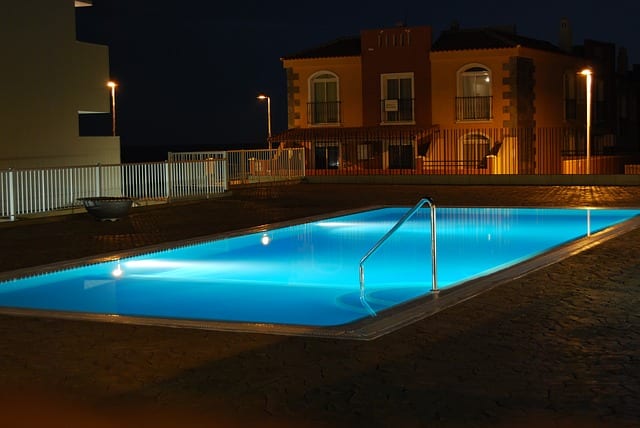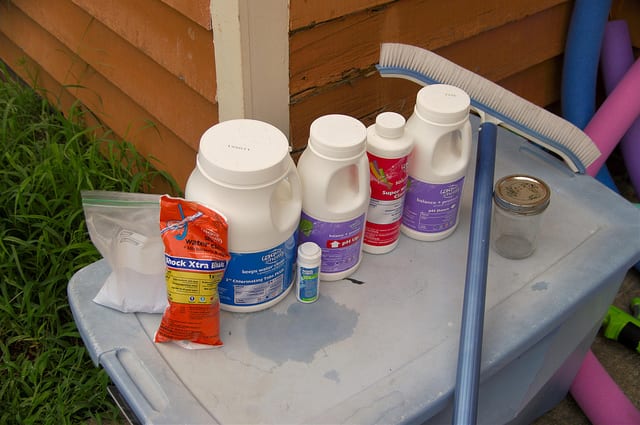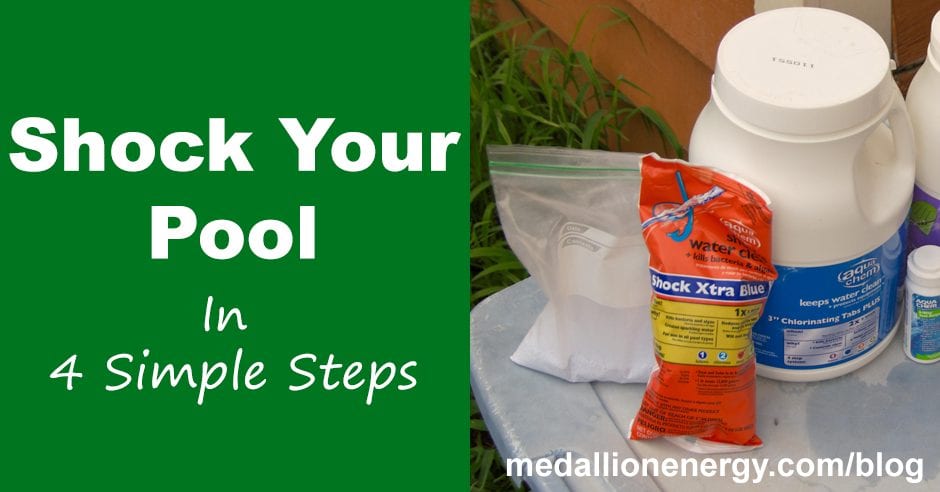Every pool owner knows it’s important to shock your pool. But what exactly does it mean to shock a pool?
[New pool owner? Have a whole bunch of other questions? Our Pool Owner Guide is your answer]
What does pool shock do?
Pool shock is sanitizer, or rather an oxidizing compound designed to kill bacteria and destroy chloramines. And in case you were wondering, chloramines are just what’s left when chlorine becomes used up. Or in other words, what’s left when it bonds to a contaminant. They serve no purpose aside from adding to the debris in your pool. And they’re often the culprit behind cloudy pool water. Hence why shocking your pool is so important. It oxidizes leftover “dead” chlorine and keeps your pool clean. And it’s during oxidation that you’ll notice the familiar smell of chlorine. That’s chloramines being
Hence why shocking your pool is so important. It oxidizes “dead” chlorine and keeps your pool clean. And it’s during oxidation that you’ll notice the familiar smell of chlorine. That’s just chloramines being converted into gas.
How often should you shock a pool
The answer to this question depends largely on how often you use your pool. But shocking your pool 2 to 4 times per month is a good place to start.
A more technical answer involves monitoring your Free Chlorine and Total Chlorine levels. Free Chlorine represents how much of your chlorine is still active and unused. While Total Chlorine represents how much has been used up/converted into chloramines.
When your Total Chlorine is higher than your Free Chlorine, it’s time to shock the pool.
It’s also a good rule of thumb to shock your pool after heavy swim sessions or pool parties. This is when your chemicals levels are most likely to become abruptly imbalanced. And it’s better to get them back in order early on than to wait and let them get out of control. Which is what good pool care is all about.
When should I shock my pool



You already know how often to shock your pool, and under what conditions. But is there a certain time that’s optimal for doing so?
Yes, in fact, there is.
Always strive to shock your pool at night, for a few reasons:
- Most pool shocks have a wait time of 8 hours
- Sunlight significantly weakens (burns off) chlorine effectiveness
- You’ll need to run you filter/pool pump (cheaper to run at night)
- Easier to keep cool during the process
Different kinds of pool shock
Before we get into the actual process of shocking your pool, let’s go over the 4 types of pool shock. Each accomplishes the same task, but are individually better suited for certain situations:
-Calcium hypochlorite
In most situations, this will be your go-to pool shock. It’s the cheapest and contains the most chlorine at 65%. And as the name implies, it also adds a healthy dose of calcium to your water as well. That being said, if excessive calcium levels are a problem you’re currently facing then this shock may not be the best option. But otherwise, calcium hypochlorite is pretty simple to add requiring a standard pre-dissolve.
- Chlorine content: 65%
- Wait Time: 8 hours
- Side effect: Adds chlorine to water
- Pre-dissolve required
-Lithium hypochlorite
If calcium content is a major factor, then this is the pool shock for you. Lithium hypochlorite contains zero calcium and doesn’t require pre-dissolving. It can be added straight into the water. But a wait time of about 8 hours is still needed.
- Chlorine content: 35%
- Wait Time: 8 hours
- Side effect: N/A
- No pre-dissolve needed
-DiChlor shock
With a chlorine content of 60% and no pre-dissolve required, DiChlor shock is another great option for pool owners in a pinch. And it’s especially helpful for those living in sunnier areas, as it contains small doses of cyanuric acid. A chlorine stabilizer that acts as sunblock against those burning rays.
- Chlorine content: 60%
- Wait time: 8 hours
- Side effect: Adds cyanuric acid
- No pre-dissolve needed
-Potassium peroxymonosulfate
Known as the chlorine-free pool shock, Potassium Peroxymonosulfate is ideal for pool owners who use bromine as opposed to chlorine. But it’s still safe to use with chlorine pools. And it’s the fastest acting shock with a wait time of just 15 minutes. So it’s great for those last-minute restorations. Unfortunately, it’s also the most expensive, so use when needed:
- Chlorine content: None
- Wait time: 15 minutes
- Side effects: N/A
- No pre-dissolved needed
-*Bleach
Although it’s a generally accepted practice, we don’t recommend that you shock your pool with bleach. No, not because it’s dangerous or super expensive or anything like that really. Rather because it’s simply just not as effective as actual pool shock. It still adds chlorine to your water and disinfects. But you need much more of it in most cases as opposed to standard shock. So opt for shocking your pool with bleach in emergency situations only.



How To Shock Your Pool
Once you’ve decided which type of shock you want to use, shocking the pool is easy. Just follow these simple steps:
1.) Prepare the pool shock
Grab a 5-gallon bucket and your pool shock.
Fill the bucket with pool water (about 3/4th full) and slowly add your shock.
How much pool shock do I use?
Combine 1 pound of pool shock with 5 gallons of water (in bucket)
IMPORTANT: Always add shock to water. Do not add water to shock.
2.) Stir the bucket
Use a mixing stick to dissolve the shock into the 5-gallon bucket
3.) Distribute the shock
Make sure your filter is running.
Pour the contents of the bucket into the water as you walk around the perimeter of the pool. The goal here is to evenly distribute the shock.
- Pour close to the surface to avoid splashback on skin and clothing
- Pour around return jets to quickly spread shock
4.) Wait and Test
Wait the specified amount of time required for the pool shock you chose. Then take out your test kit, and check all of your chemical levels before hopping back in.
Helpful Pool Shock Tips
- Use protective eyewear and gloves
- Use warm water to dissolve faster
- 1 gallon of shock per 5-gallon bucket of water
- Add shock to water
- Don’t mix different pool shocks
- Shock your pool at night (avoid shocking pool during day)
Closing Notes
We hope this mini-guide makes it easy to shock your pool. As you’ve learned from this post, shocking your pool is pretty simple. It all comes down to picking the right shock, preparing it, and distributing it into your water. Chemistry and your filter system take care of the rest.
But maybe you still have a few more questions about your pool. Especially when it comes to pool maintenance. In that case, our Pool Owner Guide is the perfect resource for you. It covers just about everything you need to know to run a clean and healthy swimming pool.
And if you’re in the market for a new pool heater (or just want to do a bit of research) be sure to check out our post on how to choose the best pool heater.


